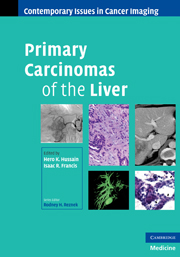Book contents
- Frontmatter
- Contents
- Contributors
- Series foreword
- Preface to Primary Carcinomas of the Liver
- 1 Epidemiology of hepatocellular carcinoma and cholangiocarcinoma
- 2 Surveillance and screening for hepatocellular carcinoma
- 3 Pathology of hepatocellular carcinoma, cholangiocarcinoma, and combined hepatocellular-cholangiocarcinoma
- 4 Radiological diagnosis of hepatocellular carcinoma
- 5 Staging of hepatocellular carcinoma
- 6 Surgical treatment of hepatocellular carcinoma: resection and transplantation
- 7 Non-surgical treatment of hepatocellular carcinoma
- 8 Radiological identification of residual and recurrent hepatocellular carcinoma
- 9 Radiological diagnosis of cholangiocarcinoma
- 10 Staging of cholangiocarcinoma
- 11 Treatment of cholangiocarcinoma
- 12 Uncommon hepatic tumors
- Index
- Color plates
- References
3 - Pathology of hepatocellular carcinoma, cholangiocarcinoma, and combined hepatocellular-cholangiocarcinoma
Published online by Cambridge University Press: 04 August 2010
- Frontmatter
- Contents
- Contributors
- Series foreword
- Preface to Primary Carcinomas of the Liver
- 1 Epidemiology of hepatocellular carcinoma and cholangiocarcinoma
- 2 Surveillance and screening for hepatocellular carcinoma
- 3 Pathology of hepatocellular carcinoma, cholangiocarcinoma, and combined hepatocellular-cholangiocarcinoma
- 4 Radiological diagnosis of hepatocellular carcinoma
- 5 Staging of hepatocellular carcinoma
- 6 Surgical treatment of hepatocellular carcinoma: resection and transplantation
- 7 Non-surgical treatment of hepatocellular carcinoma
- 8 Radiological identification of residual and recurrent hepatocellular carcinoma
- 9 Radiological diagnosis of cholangiocarcinoma
- 10 Staging of cholangiocarcinoma
- 11 Treatment of cholangiocarcinoma
- 12 Uncommon hepatic tumors
- Index
- Color plates
- References
Summary
As with any organ or organ system, the liver is the site of a wide variety of neoplasms, both benign and malignant. Overall, the most common primary neoplasm in the liver is the hemangioma, a benign vascular neoplasm that rarely causes diagnostic difficulty. Primary malignant neoplasms include hepatocellular carcinoma (HCC), cholangiocarcinoma (CCA), sarcomas, and an assortment of rare tumors of other types. In adults, the two most common primary malignant tumors are HCC and CCA. Some tumors are mixtures of the two. These two common malignancies will be the topics of the following discussion.
Hepatocellular carcinoma
HCC is a malignant tumor of hepatocytes occurring most commonly in older adults, and is associated with several etiologic factors, including hepatitis B and C, and cirrhosis resulting from steatohepatitis, hemochromatosis, and other causes. Pathologic evaluation of HCC may occur as part of an initial diagnosis when a liver biopsy or fine-needle aspiration (FNA) may yield limited material for study, or when tumors are resected.
Macroscopic features
HCC are typically present within cirrhotic livers, in which they develop fibrous capsules and fibrous intratumoral septae as they enlarge, giving them a firm consistency. Necrosis and intratumoral hemorrhage may be present (Figure 3.1). Satellite nodules may be present at the periphery of large tumors. In non-cirrhotic livers, HCC tends to be softer and unencapsulated. Although one large mass is characteristic, some patients present with several or multiple masses throughout the liver. Multiple small HCC may be difficult to distinguish from nodules of cirrhosis.
- Type
- Chapter
- Information
- Primary Carcinomas of the Liver , pp. 16 - 32Publisher: Cambridge University PressPrint publication year: 2009



